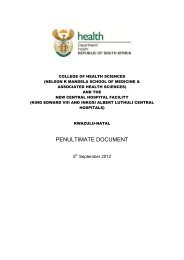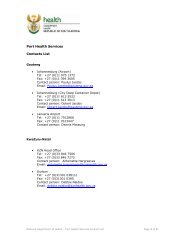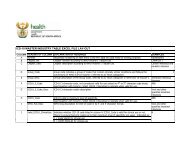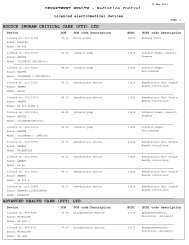eHealth Strategy South Africa 2012 - Department of Health
eHealth Strategy South Africa 2012 - Department of Health
eHealth Strategy South Africa 2012 - Department of Health
You also want an ePaper? Increase the reach of your titles
YUMPU automatically turns print PDFs into web optimized ePapers that Google loves.
National <strong>e<strong>Health</strong></strong> <strong>Strategy</strong>, <strong>South</strong> <strong>Africa</strong> <strong>2012</strong>/13-2016/17<br />
Some <strong>of</strong> the successful national systems which are in place are:<br />
• District <strong>Health</strong> Information System (DHIS): a system used nationally which records routine information<br />
on facility-based services, community-based campaigns, infrastructure and human resources.<br />
• National Electronic TB Register: a system that monitors cohort groups <strong>of</strong> TB patients, with more than<br />
200 users across the country.<br />
• Western Cape Primary <strong>Health</strong>care Information System (PHCIS) and Patient Master Index (PMI).<br />
The national Tiered <strong>Strategy</strong> for ART Monitoring<br />
In December 2010, the National <strong>Health</strong> Council (NHC) technical task team approved the Tiered ART<br />
Monitoring <strong>Strategy</strong> comprising <strong>of</strong> a paper-based register (the ART register), non-networked electronic<br />
register (TIER.net) and a networked disease specific EMR system (SMARTER 39 ) for HIV/ART patient<br />
monitoring in line with the WHO’s 3 Tiered ART M&E strategy. The strategy provides the tools to standardise<br />
ART monitoring nationally with a system that best suits the various needs <strong>of</strong> facilities, sub-districts, districts<br />
and provinces and the resources available to manage the systems.<br />
All three tiers <strong>of</strong> the 3-Tiered ART Monitoring System are mutually exclusive and generate the same core<br />
set <strong>of</strong> data reported into the DHIS as the centralized aggregated database for all health information. As<br />
guidelines, the paper-based register is suited for facilities with no electricity or no computer and with<br />
less than 500 patients. The electronic register (TIER.net) is suited for facilities with regular electricity, a<br />
computer, no network infrastructure and with 500-2,000 patients. The EMR (SMARTER) is suited for facilities<br />
with network infrastructure and over 2,000 patients. TIER.net and SMARTER <strong>of</strong>fer increased functionality<br />
where ICT infrastructure and capacity exist to manage the system.<br />
This is a visionary and practical initiative by the NDOH which addresses the variation in <strong>e<strong>Health</strong></strong> maturity<br />
and readiness across the country. The concept <strong>of</strong> the three tiers means that depending on patient load,<br />
capacity and <strong>e<strong>Health</strong></strong> readiness facilities providing ART will monitor treatment using one <strong>of</strong> the three<br />
systems.<br />
5. <strong>e<strong>Health</strong></strong>’s contribution to NDoH’s strategic aims<br />
5.1 The <strong>Health</strong> Context<br />
The <strong>South</strong> <strong>Africa</strong>n population has grown from 46,5million people in 2004 to 49,9 million in 2010. The<br />
burden <strong>of</strong> disease confronting the country has also increased. <strong>South</strong> <strong>Africa</strong> is faced with a quadruple burden<br />
<strong>of</strong> diseases consisting <strong>of</strong> HIV & AIDS and TB; high maternal and child mortality; non-communicable diseases;<br />
and violence and injuries.<br />
To address this, the National <strong>Department</strong> <strong>of</strong> <strong>Health</strong> has developed a five-year macro plan for the health<br />
sector, detailed in Outcome 2 <strong>of</strong> the Negotiated Service Delivery Agreement 2010-2014 (NSDA), which will<br />
harness the efforts <strong>of</strong> the country towards the vision <strong>of</strong>: “A long and healthy life for all <strong>South</strong> <strong>Africa</strong>ns”. The<br />
NSDA requires the health sector to achieve four outputs namely:<br />
(i) Increasing life expectancy.<br />
(ii) Decreasing maternal and child mortality.<br />
(iii) Combating HIV and AIDS and decreasing the burden <strong>of</strong> disease from tuberculosis.<br />
(iv) Strengthening health system effectiveness.<br />
39 Systematic Monitoring <strong>of</strong> ART Evaluation and Reporting<br />
Page 20


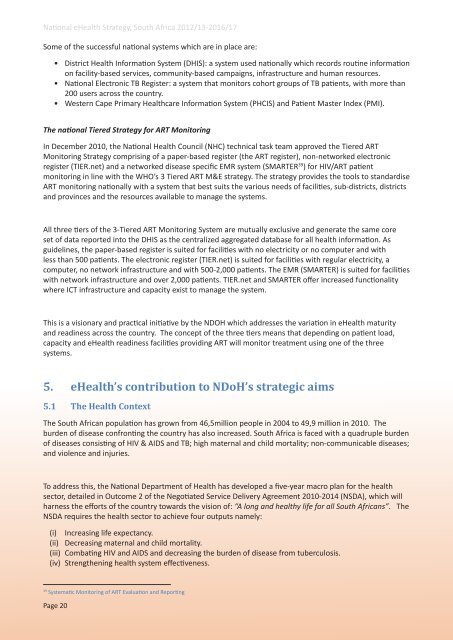
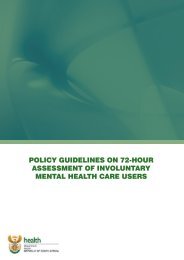
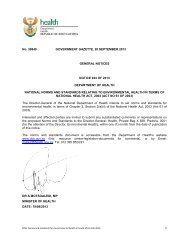

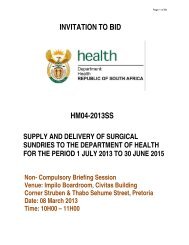
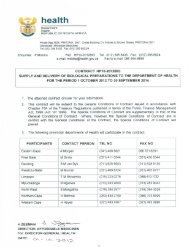
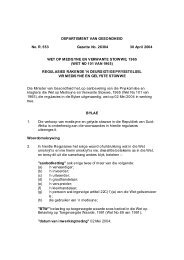
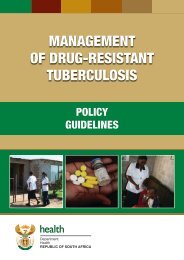
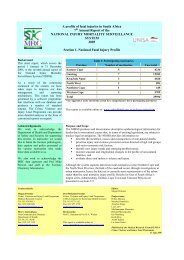
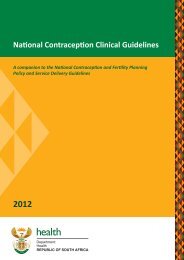
![A monograph of the management of postpartum haemorrhage [2011]](https://img.yumpu.com/15578784/1/184x260/a-monograph-of-the-management-of-postpartum-haemorrhage-2011.jpg?quality=85)
